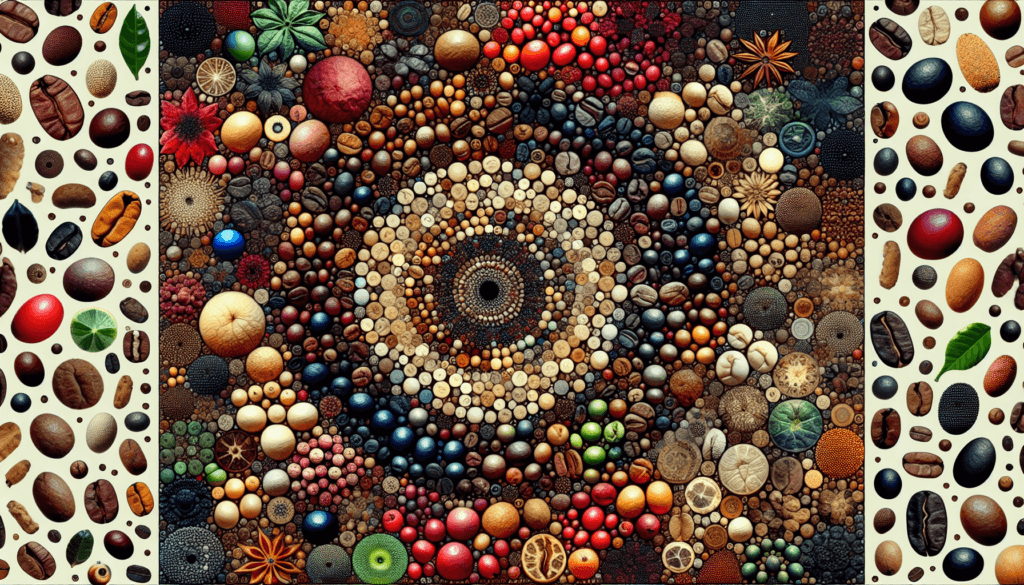Imagine a world without the comforting aroma of freshly brewed coffee. It’s hard to fathom, isn’t it? Coffee has become a beloved beverage enjoyed by millions around the globe, but have you ever wondered just how many different species of coffee exist in the world? From the familiar Arabica and Robusta to the lesser-known Liberica and Excelsa, the diversity of coffee species is truly remarkable. Join us on a journey to uncover the fascinating world of coffee and discover just how many species are out there waiting to be explored. Are you ready to embark on this caffeinated adventure? Let’s dive in!
History of Coffee
Discovery of Coffee
The history of coffee dates back many centuries, with its origins believed to be in Ethiopia. According to popular legend, coffee was first discovered by a goat herder named Kaldi. As the story goes, Kaldi noticed that his goats became unusually energetic and lively after consuming the berries from a certain tree. Intrigued by this discovery, he shared it with the local monks, who began experimenting with the berries and eventually brewed the first cup of coffee.
Spread of Coffee Cultivation
From its humble beginnings in Ethiopia, the cultivation of coffee spread throughout the Arabian Peninsula, where it became an integral part of the culture and social fabric. Coffeehouses or “qahveh khaneh” were established, serving as meeting places where intellectuals, scholars, and artists would gather to discuss literature, politics, and philosophy. It was during the 16th century that coffee reached Europe, and its popularity quickly surged, leading to the establishment of coffeehouses in major cities like London and Paris.
Varieties of Coffee
Coffee is not a single species but encompasses a wide range of varieties. The two most commonly recognized coffee species are Arabica and Robusta, but there are also lesser-known species such as Excelsa, Liberica, and Stenophylla. Each of these coffee species has its own unique characteristics, growing conditions, and flavor profiles, contributing to the diverse world of coffee that we enjoy today.
Coffee Classification
Arabica Coffee
Arabica coffee, scientifically known as Coffea arabica, is considered the superior species in terms of flavor and complexity. Originating from the highlands of Ethiopia, Arabica coffee now thrives across the globe in regions with altitudes between 2,000 and 6,000 feet. It requires mild temperatures, rainfall, well-drained soil, and shade to flourish. Arabica coffee is known for its nuanced flavors, which can range from fruity and floral to chocolatey and nutty, making it a favorite among coffee enthusiasts.
Robusta Coffee
Robusta coffee, scientifically known as Coffea canephora, is a hardy species that is resilient to diseases and pests. It is primarily grown in regions with lower altitudes, such as Africa, Vietnam, and Brazil. Robusta coffee can withstand higher temperatures and has a higher caffeine content compared to Arabica. It is known for its strong, bold flavors, often exhibiting earthy, woody, and bitter notes. While it may not have the same esteemed reputation as Arabica, Robusta coffee plays a crucial role in espresso blends and instant coffee production due to its affordability and robustness.
Other Coffee Species
In addition to Arabica and Robusta, there are other coffee species that are less commonly consumed but still play a significant role in coffee production. Excelsa coffee, for example, is grown in Southeast Asia and has a tart, fruity flavor. Liberica coffee, primarily cultivated in the Philippines, has a distinctive smoky and floral taste. Stenophylla coffee, found in West Africa, is appreciated for its complexity and citrusy notes. While these coffee species may not be as widely available or well-known, they contribute to the diversity and range of flavors in the coffee world.

Arabica Coffee
Origin and Distribution
Arabica coffee originated in the highlands of Ethiopia and is believed to be the first coffee species to be cultivated. Over time, it spread to other African countries and eventually made its way to the Arabian Peninsula, where it gained popularity among traders and travelers. Today, Arabica coffee is grown across the globe in countries such as Brazil, Colombia, Ethiopia, and Costa Rica.
Growing Conditions
Arabica coffee thrives in regions with altitudes between 2,000 and 6,000 feet. It requires a mild, subtropical climate with temperatures ranging between 60°F and 70°F. The right amount of rainfall, evenly distributed throughout the year, is crucial for its growth. Additionally, Arabica coffee prefers well-drained soil with good organic content. To protect the delicate coffee cherries, shade trees are often grown alongside the Arabica plants to create a suitable microclimate.
Flavor Profile
Arabica coffee is renowned for its nuanced and complex flavors. It offers a wide range of taste profiles, which can vary depending on factors such as soil conditions, altitude, and processing methods. Arabica beans exhibit flavors that can be described as fruity (e.g., berries, citrus), floral (e.g., jasmine, lavender), or nutty (e.g., almond, hazelnut). The balanced acidity, mild body, and overall smoothness make Arabica coffee highly desirable and sought after by coffee connoisseurs.
Robusta Coffee
Origin and Distribution
Robusta coffee originated in Central and Western Africa, particularly in countries like Uganda and the Democratic Republic of Congo. It is now grown in other regions around the world, including Asia and Brazil. Unlike Arabica coffee, Robusta is a heartier species that can withstand varying climatic conditions, making it more adaptable to different geographical regions.
Growing Conditions
Robusta coffee is typically cultivated at lower altitudes, ranging from sea level to about 2,500 feet. It can thrive in hotter temperatures, ranging from 75°F to 85°F. Compared to Arabica, Robusta requires less rainfall, but consistent moisture is still necessary for optimal growth. Additionally, Robusta coffee plants are more tolerant of direct sunlight and can be grown in full sun. These factors contribute to the robustness and disease resistance of the Robusta coffee species.
Flavor Profile
Robusta coffee is known for its strong, bitter flavor profile. Its taste often exhibits earthy, woody, and even rubbery notes. Robusta contains more caffeine than Arabica, contributing to its characteristic bitterness. While its flavor profile may not be as complex as Arabica, it is valued for its ability to add depth and body to coffee blends, particularly in espresso. Due to its affordability and strong character, Robusta coffee remains an essential component in the global coffee industry.

Other Coffee Species
Excelsa Coffee
Excelsa coffee, also known as Coffea liberica var. dewevrei, is a variety of the Liberica coffee species. It is primarily grown in Southeast Asia, including countries like Malaysia and the Philippines. Excelsa coffee beans have a distinct oval shape and are typically larger than Arabica and Robusta beans. They possess a unique flavor profile, often characterized as tart, fruity, and possessing notes of dark berries. While not as widely consumed as Arabica or Robusta, Excelsa coffee adds an interesting dimension to the diverse world of coffee.
Liberica Coffee
Liberica coffee, scientifically known as Coffea liberica, has a rich history in the Philippines, where it was introduced during the Spanish colonial period. Liberica trees are known for their large leaves and robust nature, making them less susceptible to diseases. Liberica coffee beans have a distinct and pronounced flavor, often described as smoky, woody, and with floral undertones. Although the production and consumption of Liberica coffee are relatively limited compared to Arabica and Robusta, it holds cultural significance in its regions of cultivation.
Stenophylla Coffee
Stenophylla coffee, scientifically known as Coffea stenophylla, is a lesser-known coffee species that originated in West Africa. It is primarily grown in Sierra Leone and Guinea. Stenophylla coffee is appreciated for its complexity and unique flavor profile. It often exhibits citrusy and floral notes, adding a refreshing and vibrant character to coffee blends. While Stenophylla is not as prevalent or widely cultivated as Arabica or Robusta, it showcases the rich diversity of coffee species available.
Coffee Species Exploration
Scientific Research
Scientific research plays a vital role in exploring and understanding the many coffee species present in the world. Botanists and agricultural scientists conduct field studies, collect samples, and analyze genetic data to classify and document coffee species. These studies provide valuable insights into the genetic diversity, origins, and potential characteristics of different coffee species.
Genetic Analysis
Genetic analysis is a crucial tool in coffee species exploration. By examining the DNA and genetic makeup of various coffee species, researchers can identify unique genetic markers, understand evolutionary relationships, and predict the potential traits and flavors exhibited by different species. Genetic analysis also helps identify rare and distinct coffee species, contributing to the preservation and appreciation of biodiversity within the coffee world.
New Discoveries
Advancements in scientific techniques and exploration efforts have led to the discovery of previously unknown coffee species. Through careful examination and analysis, scientists have identified new species within the Arabica and Liberica families, further expanding the understanding and diversity of the coffee plant. These discoveries not only enrich the knowledge of coffee enthusiasts but also highlight the need for continued exploration and research to uncover potential hidden gems within the coffee world.

Challenges in Coffee Classification
Hybridization
One of the challenges in coffee classification arises from natural hybridization between different coffee species. Cross-pollination between Arabica and Robusta, for example, can result in hybrid varieties that can be challenging to categorize accurately. These hybrids may possess characteristics from both parent species, making precise classification a complex endeavor. Hybridization also adds an additional layer of diversity within the coffee gene pool, further highlighting the intricate nature of coffee classification.
Undocumented Species
Despite ongoing research and exploration, there may still be undocumented or undiscovered coffee species in remote or inaccessible regions. The vastness of coffee-growing regions across the globe, combined with the potential for numerous undiscovered species, presents a challenge in achieving a comprehensive understanding of coffee diversity. Continued efforts to explore and document these unknown species are crucial for the coffee industry and conservationists alike.
Misidentification
Misidentification of coffee species can occur due to similarities in appearance or limited information in certain regions. In areas where coffee cultivation is not the primary focus or where genetic analysis capabilities are limited, accurate species identification may be challenging. Misidentification can lead to incorrect labeling, trade disputes, and difficulties in conserving or preserving specific coffee species. Enhanced education, collaboration, and accurate documentation are essential in addressing these challenges and promoting correct coffee classification.
Conservation and Preservation
Importance of Conservation
Conservation of coffee species is crucial for preserving biodiversity and ensuring the sustainability of the coffee industry. Coffee plants provide habitat for various animal and plant species, contribute to ecological balance, and play a vital role in the livelihoods of millions of people worldwide. By conserving and preserving coffee species, we protect not only a valuable agricultural crop but also the interconnected ecosystems that rely on coffee plantations.
Conservation Efforts
Numerous organizations, governments, and farmers actively participate in coffee conservation efforts. These initiatives focus on preserving genetic diversity, promoting sustainable cultivation practices, and raising awareness about the importance of preserving lesser-known coffee species. Conservation efforts involve establishing protected areas, implementing sustainable farming techniques, and supporting local communities to ensure the long-term viability of coffee and its associated ecosystems.
Seed Banks
Seed banks play a crucial role in coffee species conservation. These institutions collect, store, and catalog coffee seeds from various species and varieties. By maintaining a robust seed bank, researchers, farmers, and conservationists can access and utilize genetic resources to cultivate and preserve diverse coffee species. Seed banks serve as repositories of genetic material, providing a safety net in the event of natural disasters, diseases, or other threats to coffee biodiversity.

Implications for Coffee Industry
Quality and Flavor Variations
The diverse range of coffee species and varieties has significant implications for the coffee industry. Each species brings forth unique flavor profiles and characteristics, allowing for a wide array of taste experiences for coffee lovers. The distinct qualities of Arabica, Robusta, and other coffee species enable coffee roasters and blenders to create complex and innovative blends. Furthermore, the appreciation for specialty and single-origin coffees has grown, highlighting the desire for distinct flavors and preserving the integrity of each coffee species.
Sustainable Cultivation
Understanding and preserving coffee species is vital for the sustainability of coffee cultivation. By conserving genetic diversity, coffee farmers have access to crops that can withstand diseases, climate change, and other environmental challenges. Additionally, sustainable cultivation practices, such as shade-grown coffee and organic farming, contribute to the preservation of coffee species and their ecosystems. Supporting sustainable cultivation methods ensures the long-term viability of coffee production while safeguarding the diverse coffee species that make it possible.
Market Trends
The appreciation for coffee diversity has influenced market trends and consumer preferences. Some coffee enthusiasts actively seek out unique and rare coffee species, embracing the idea of exploring flavors beyond the traditional Arabica or Robusta. Specialty coffee shops and roasters have responded to this demand by showcasing different coffee species and origin-specific offerings. As consumers become more educated and curious about coffee, the market continues to evolve to cater to their desire for variety and exploration.
Conclusion
Understanding Coffee Diversity
The history of coffee and its diverse range of species is a testament to the rich heritage and cultural significance of this beloved beverage. From the discovery of coffee in Ethiopia to the global cultivation and exploration of coffee species, the coffee industry has thrived on the remarkable diversity that coffee offers. By understanding and appreciating the different species and their unique characteristics, we can celebrate the intricate flavors and qualities that make coffee a beloved beverage worldwide.
Further Research
While considerable progress has been made in coffee classification and conservation, further research is necessary to continue uncovering the full extent of coffee species diversity. Efforts in genetic analysis, exploration, and documentation will shed light on unknown species, their potential flavors, and their ecological significance. This research will enable us to enhance conservation efforts, promote sustainable cultivation practices, and preserve the beautiful variety that coffee offers. As we embark on this journey of discovery, we are bound to unearth new and exciting chapters in the history of coffee.



